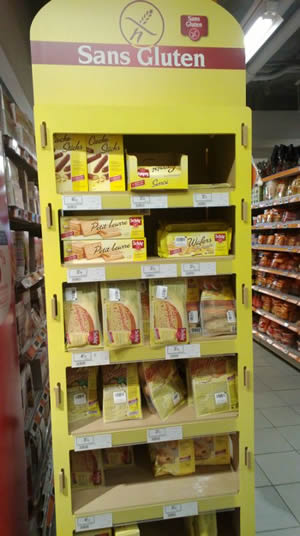Commentary
What is it about GLUTEN?
 A supermarket in France carrying a Gluten free counter (taken in April 2014 by Ruth Oniang’o) |
All of a sudden there is this craze about gluten free products. I have a friend in Africa who is allergic to wheat and so avoids wheat products and anything that has wheat in it. Then more recently as I visited the USA and Europe, I come across people who are on gluten free diets, and for no apparent reason. Many of the ones I have talked to just believe gluten is not good for them.
What is gluten? I learnt of gluten during my early studies, as a wheat protein, a unique protein that gave wheat flour its elastic properties, enabling it to perform well in breads that needed to rise. It is a mixture of two proteins-gliadins and glutelins.
As far as is known, only wheat as a cereal contains appreciable amounts of gluten to be concerned about. Not even sticky rice contains gluten. This explains why yeast or baking powder can be used in wheat products to make them rise. Gluten is the facilitating protein here.
Apart from the leavened breads and other wheat products we know of, many other products including condiments have gluten in them as wheat flour may have been used in their processing. This is where labels become important, and even more important is reading such labels especially if one has allergies.
Jane Anderson writing in About.com about Celiac Disease symptoms stated “Although the best-known (but not necessarily most common) symptoms of celiac disease include smelly diarrhea, abdominal pain, weight loss and fatigue, celiac can affect just about every system in your body, including your skin, your hormones and your bones and joints”.
“People with celiac disease might suffer from constipation instead of diarrhea, experience weight gain instead of weight loss and endure heartburn instead of stomach pain. They might also have absolutely no symptoms at all, or they might appear at their doctor's office with one seemingly unrelated symptom, such as unexplained anemia”.
Celiac disease is managed by a wheat-free diet.
My African friend does not even call her condition Celiac disease or condition. She just says she is allergic to wheat and wheat products and must, therefore, avoid it at all cost. Some people are just avoiding gluten because someone has advised it, and not for any specific reasons. I wonder what is the state of wheat allergies in Africa, in Kenya? How many people have the allergy and yet may not be aware, since allergies are not easy to determine?
Wheat is a new cereal to Africa.
Writing for FAO in 2002, in Wheat in the world, B.C. Curtis states (paraphrased) cultivation of wheat (Triticum spp.) dates far back into history as wheat was one of the first domesticated food crops and for 8 000 years has been the basic staple food of the major civilizations of Europe, West Asia and North Africa. Today, wheat is grown on more land area than any other commercial crop and continues to be the most important food grain source for humans. Wheat production leads all crops, including rice, maize and potatoes.
Wheat consumption has spread throughout the world and continues to grow. Many of us in Africa eat bread as a luxury, because it tends to be expensive. Nobel laureate Dr Norman Borlaug whose centenary is being marked this year spent years of his research working on wheat rust with yields being raised by 20 to 40%. Work to control wheat rust and other wheat diseases still continues. In food processing, wheat starch is used in many products as a thickener, as a filler and as an additive.
Finger millet, sorghum, teff and pearl millet are examples of indigenous African cereals, which are considered healthy because they have a low glycemic index and are in fact recommended for diabetic patients. It now seems that all these African cereals may have value in not having gluten. Meantime if you are not sure of your allergies, check out gluten.
Ruth Oniang’o
Editor-in-Chief, AJFAND




